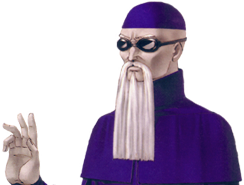Nihon Telenet’s
Digital Devil Story: Megami Tensei
Digital Devil Story Megami Tensei (デジタル・デビル物語 女神転生)
MSX
Japanese Release: July, 1987
PC-88 Japanese Release: August, 1987
FM-77 Japanese Release: September, 1987
Retail Price: Unknown
US Release: N/A
In the Summer of 1987, Nihon Telenet Japan began releasing the first game incarnation of the Digital Devil Story book series. This game appeared on three separate Japanese-centered computer systems that differed rather significantly in power.
The MSX version was the first to be released. While this computer system is relatively unknown in the United States and elsewhere, it had an extremely strong following in Japan and parts of Southern America and Europe. It was developed by team headed by Kazuhiko Nishi at Microsoft Japan in an effort to create a computer standard across a variety of companies, much like what had been established with VHS. Any company that had the rights was able to make MSX branded computers and thus consumers could buy ones manufactured by Panasonic, Sony and other big names. While not extremely powerful, the MSX was more than capable and became a standard in its home country. Various versions and upgrades took place over the years resulting in systems such as the MSX2 and the MSX Turbo R.
Digital Devil Monogatari: Megami Tensei on the MSX is easily the least impressive of the various ports. The MSX at the time was capable of only a handful of colors, PC-speaker sound quality and a low resolution. However, the basic concepts of gameplay are the same in each version despite the limitations.
In the title, players take the role of Akemi Nakajima from the Digital Devil Story novels, although most of the story is ignored. While later titles from Namcot and Atlus explore the first-person dungeon hacking route, Telenet's version instead plays much like Midway's Gauntlet. The player is given a bird's eye view of the character and must guide him through mazes gather items and killing enemies. Unfortunately, the game lacks the diversity and interest that even the original, mediocre home console ports of Gauntlet possessed. Enemies are repeated ad nauseum and the mazes themselves are uninteresting and seem to go on indefinitely from floor to floor. While the graphics are certainly poor in the today's age, they weren't exactly impressive around the time of its release either. The music consists of the same looping theme regardless of how far you progress into the title. The game even features some weird English misspellings that are absent from later versions.
The PC-88 (another Japanese focused computer system, more similar in appearance to standard IBM PCs of the time) version that released soon afterwards was a significant improvement; at least in terms of presentation. Instantly it features a far more interesting logo (as well as a pseudo-3D Telenet logo) and a separate title screen theme. The game itself is largely unchanged, but thanks to the extra power of the PC-88 it features radically improved graphics, better screen scrolling, improved music and a higher resolution. This allows the player to more easily differentiate between the monster types (which in turn are far more interesting and menacing) and makes the mazes themselves far more interesting to wander through.
The final version of Digital Devil Monogatari was released on the FM-77, a computer made by Fujitsu similar in power to the PC-88. Unfortunately, this version of the game is the most difficult to track down. It can be assumed, however, that it is extremely similar in appearance and execution to the PC-88 version that came out shortly before it.
These three versions were the only Megami Tensei related titles developed by Telenet and are generally the most difficult to come by outside of Japan. It is unclear exactly why these titles existed in such close proximity to the later, RPG styled Megami Tensei from Namcot. Normally, one would assume that each company bought the rights separately with the intent to release fundamentally different titles on different systems or at least reached some sort of agreement on something similar. Unfortunately, information on the reasoning and actions of both companies is hard to come by.
© Tony
Archives
Leave a Reply
You must be logged in to post a comment.





Megami Ibunroku Persona “Be Your True Mind”